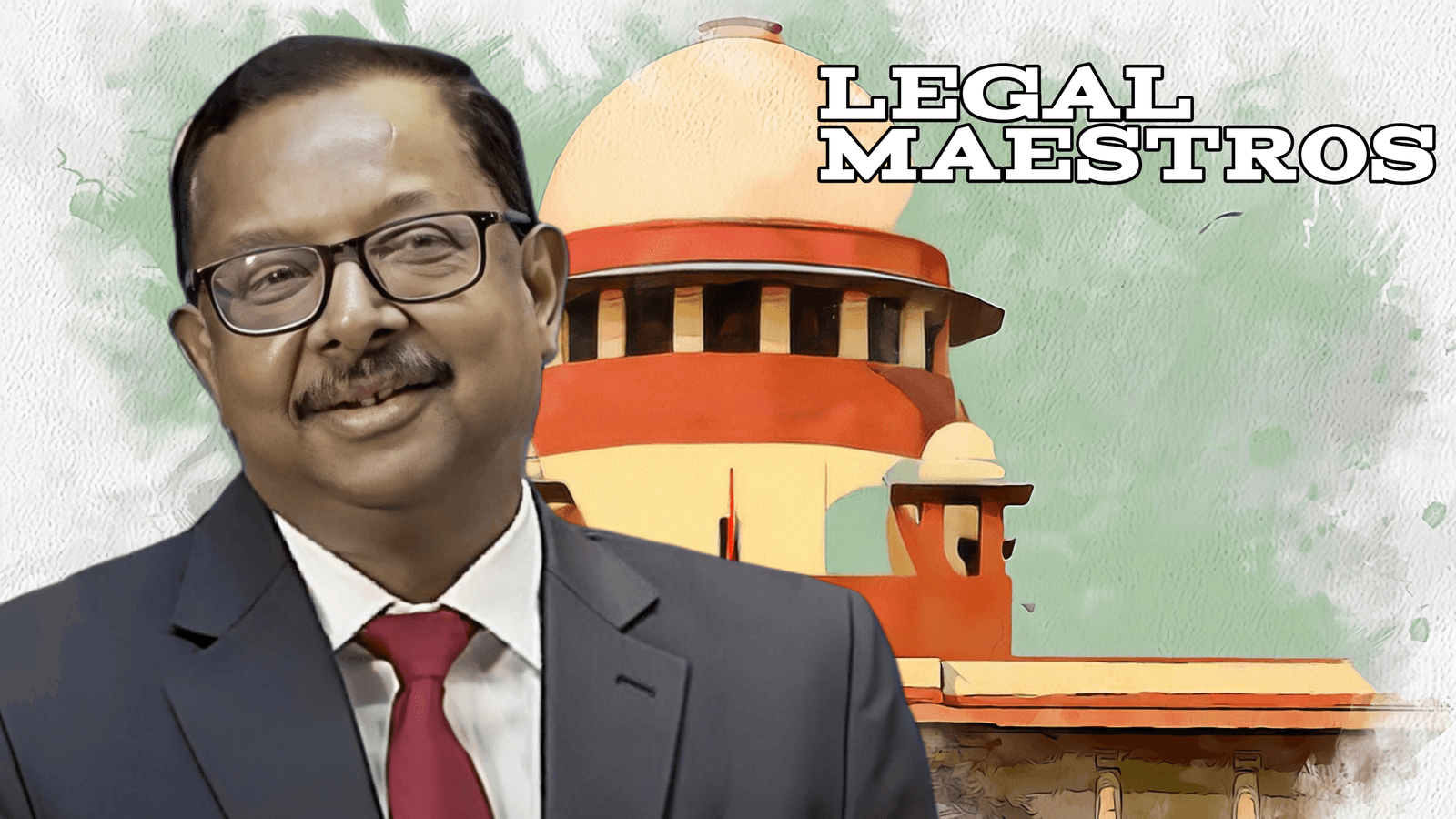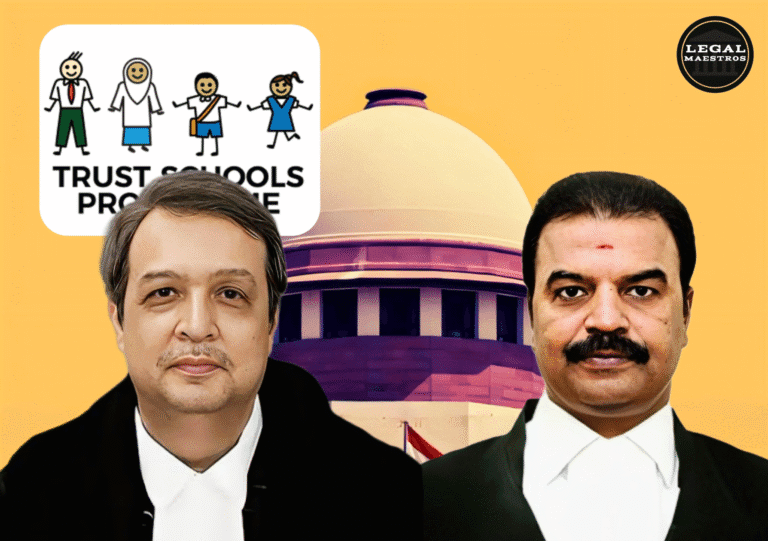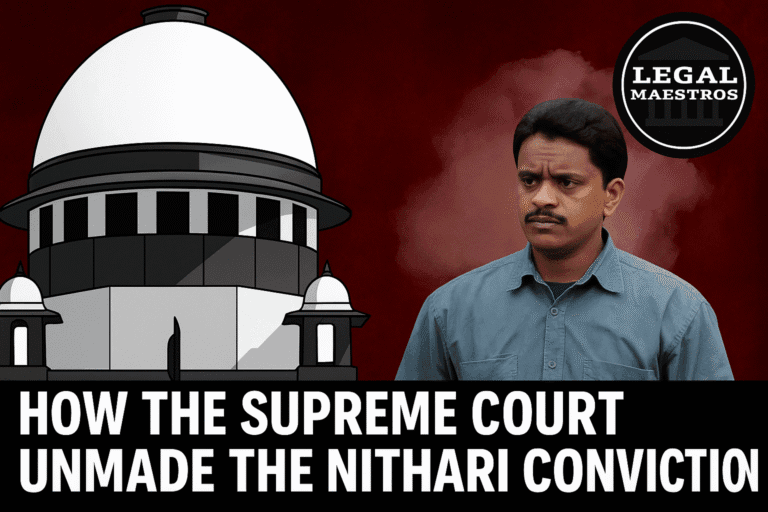
A long-standing demand of the Central Armed Police Forces (CAPFs) was finally addressed by the Supreme Court of India in a ruling that was issued in May 2025. This decision gave clarity and justice to the situation.
The lawsuit focussed on the recognition of CAPFs as Organised Group-A Services (OGAS), which includes the organizations such as the CRPF, BSF, CISF, ITBP, and SSB. Additionally, the case focused on the rights and benefits that result from such a categorization.
The decision of the court resolved contentious issues concerning service status, recruitment rules, cadre review, and promotions. More specifically, the decision addressed the denial of Non-Functional Financial Upgradation (NFFU) and stagnation in career advancement as a result of lateral entries from the Indian Police Service (IPS).
For any queries or to publish an article or post or advertisement on our platform, do call at +91 6377460764 or email us at contact@legalmaestros.com.
Historical context and the facts of the case
When officers from various CAPFs filed writ petitions in the Delhi High Court, they challenged the denial of the Government of India to award them the perks that are accorded to OGAS. This is what led to the conflict.
The High Court issued a finding that was divided along two lines: it recognized that CAPFs were entitled to NFFU based on earlier rulings from the Supreme Court, but it refrained from demanding a thorough change of recruiting criteria or the termination of deputation appointments.
When it came to the case of Union of India v. Harananda, the Supreme Court of India had already decided that CAPFs should be considered OGAS and should be eligible for NFFU. On the other hand, the High Court established that this pronouncement was restricted solely to monetary advantages and did not encompass any structural modifications to the norms governing service.
For any queries or to publish an article or post or advertisement on our platform, do call at +91 6377460764 or email us at contact@legalmaestros.com.
The appellants, who were comprised of Group-A officers of CAPFs, sought the Supreme Court in order to seek a more comprehensive recognition and enforcement of their rights as OGAS officials. They were dissatisfied with the narrow interpretation that was provided.
For More Updates & Regular Notes Join Our Whats App Group (https://chat.whatsapp.com/DkucckgAEJbCtXwXr2yIt0) and Telegram Group ( https://t.me/legalmaestroeducators )
All of the Most Important Legal Concerns
Within the context of this case, the Supreme Court considered three key issues:
For any queries or to publish an article or post or advertisement on our platform, do call at +91 6377460764 or email us at contact@legalmaestros.com.
The question of whether or not the CAPFs ought to be regarded as Organised Group-A Services (OGAS) for all reasons, and not just for NFFU.
The question at hand is whether the current recruitment criteria, which permit the deputation of IPS officers up to the Senior Administrative Grade (SAG), violate the principles of fairness and equal opportunity for CAPF officers.
The question is whether or not the Court has the authority to direct the reorganization of recruiting and cadre regulations in order to guarantee uniformity and eliminate service stagnation.
For any queries or to publish an article or post or advertisement on our platform, do call at +91 6377460764 or email us at contact@legalmaestros.com.
There are cited provisions and precedents.
The case relied significantly on a number of Office Memoranda (OMs) that were issued by the Department of Personnel and Training (DoPT), particularly the OM that was dated 19.11.2009 and that detailed the characteristics of an OGAS. These include the following:
up to SAG, having a hierarchical framework in place.
Making certain that direct recruitment is used to fill at least fifty percent of the Junior Time Scale (JTS) positions.
For any queries or to publish an article or post or advertisement on our platform, do call at +91 6377460764 or email us at contact@legalmaestros.com.
A promotion from within the cadre all the way up to the SAG?
A standard service norm that governs all of the different cadres.
JTS is keeping its reserves in place.
Officers of the CAPF contended that they essentially met these characteristics and that little variations were acceptable, acknowledging that the OM itself agreed that minor deviations were acceptable.
For any queries or to publish an article or post or advertisement on our platform, do call at +91 6377460764 or email us at contact@legalmaestros.com.
They also relied on past cases, such as G.J. Singh v. Union of India and Union of India v. Harananda, in which the courts held that CAPFs could be considered as OGAS despite the fact that they did not fulfill all of the technical criteria. These decisions later established the foundation upon which the current case was built.
stance taken by the government and opposition
These petitions were met with opposition from the Union Government as well as representatives of the IPS cadre. Their argument was that:
All of the OGAS qualities that were defined were not satisfied by CAPFs.
For any queries or to publish an article or post or advertisement on our platform, do call at +91 6377460764 or email us at contact@legalmaestros.com.
For the purpose of ensuring the coordination of national security and maintaining the federal framework of administration, the deputation of IPS personnel was absolutely necessary.
Rules for recruitment were developed based on the functional requirements of each unit, and any command that was universal in nature had the potential to upset the administrative equilibrium.
In addition, they noted that previous court orders did not force structural changes to be made in recruitment policies; rather, they simply granted financial parity through the National Financial Framework Unit.
For any queries or to publish an article or post or advertisement on our platform, do call at +91 6377460764 or email us at contact@legalmaestros.com.
Interpretation and Conclusions of the Supreme Court
The Supreme Court has firmly confirmed that the CAPFs are OGAS for all reasons, both practical and legal, and not just for the purpose of receiving financial assistance. It made the following observations:
CAPFs were officially acknowledged as OGAS for cadre evaluation and other relevant topics in the OM issued by the Department of Public Safety on July 12, 2019.
It was a mistake on the part of the High Court to overlook this significant change when it was delivering its judgment in 2020.
For any queries or to publish an article or post or advertisement on our platform, do call at +91 6377460764 or email us at contact@legalmaestros.com.
Articles 14 and 16 of the Constitution, which ensure equal opportunity, were violated as a result of the constant deputation of IPS officers to senior posts, which led to an unjust stagnation among CAPF officials.
Despite the fact that some CAPFs did not satisfy every aspect of OGAS at the time, the Court stated that the debate was ended due to the intention of the government and the later adoption of the idea by the government itself. Furthermore, since CAPFs were deemed to be OGAS, future cadre evaluations and recruitment standards must reflect this fact. This will ensure that promotion-based filling of jobs up to SAG is carried out.
Implications for the Rules of Recruitment and the Cadre Review
With regard to the deputation of IPS officers to upper positions in CAPFs, this was one of the most important points of dispute. The Supreme Court highlighted that senior positions in the OGAS should be filled primarily through promotions from within the service wherever possible. It instructed that the following:
For any queries or to publish an article or post or advertisement on our platform, do call at +91 6377460764 or email us at contact@legalmaestros.com.
The Department of Public Policy and the Ministry of Home Affairs are obligated to conduct an immediate review of the recruitment rules in CAPFs.
During this procedure, it is necessary to take into consideration the participation of CAPF officers.
The review of the cadre, which was supposed to be completed in 2021, must be finished without any more delay.
For any queries or to publish an article or post or advertisement on our platform, do call at +91 6377460764 or email us at contact@legalmaestros.com.
Despite the fact that some deputation could remain at Higher Administrative Grade (HAG) or Apex ranks for the purpose of coordination, the Court made it clear that an excessive dependence on deputation at several levels was not permissible.
Over 18,000 Group-A officers in CAPFs who had been pursuing justice for more than a decade made a huge step forward when the Supreme Court issued its decision in 2025. This ruling represents a significant milestone.
This statement reaffirms the overarching premise that all government employees, particularly those who are working in conditions that are challenging and demanding, must be treated with fairness in terms of the conditions of their employment and the advancement opportunities available to them.
For any queries or to publish an article or post or advertisement on our platform, do call at +91 6377460764 or email us at contact@legalmaestros.com.
Through the recognition of CAPFs as OGAS not just for NFFU but also for all reasons, including cadre reorganization and promotions, the Court has not only given a ruling, but it has also restored morale, dignity, and equality within one of the most important security institutions in the country.
Remarks to Conclude
Not only does this decision establish a precedent in the law, but it also serves as a warning to the executive branch that it should take proactive measures to change recruitment and service structures in accordance with constitutional principles and judicial pronouncements.
It also highlights the role that the judiciary plays in ensuring that administrative decisions are not made arbitrarily and that justice is provided to those individuals who devote their life to the protection and integrity of the nation.
For any queries or to publish an article or post or advertisement on our platform, do call at +91 6377460764 or email us at contact@legalmaestros.com.






![Research Assistantship @ Sahibnoor Singh Sindhu, [Remote; Stipend of Rs. 7.5k; Dec 2025 & Jan 2026]: Apply by Nov 14, 2025!](https://legalmaestros.com/wp-content/uploads/2025/11/Gemini_Generated_Image_s0k4u6s0k4u6s0k4-768x707.png)
![Karanjawala & Co Hiring Freshers for Legal Counsel [Immediate Joining; Full Time Position in Delhi]: Apply Now!](https://legalmaestros.com/wp-content/uploads/2025/11/Gemini_Generated_Image_52f8mg52f8mg52f8-768x711.png)